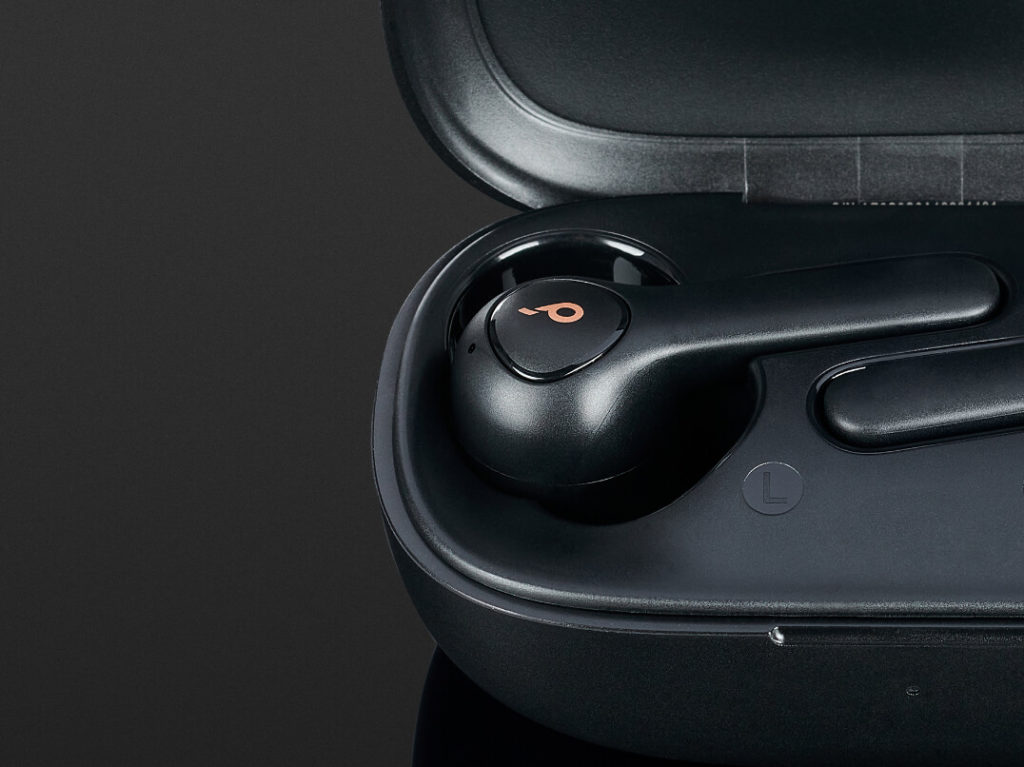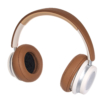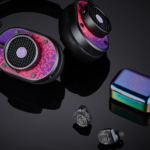[rev_slider alias=”sennheiser-hd-800-s%e2%80%8b”]
4.5/5
Sennheiser HD 800 S
Wired, open over-ear reference headphones for audiophile and professional applications
Divide:
“
The top model among Sennheiser’s open headphones, with the exception of the Orpheus HE-1, is the HD 800 S. The successor to the HD 800 from 2009 is available both in the regular black version tested here and in a limited, but technically identical Anniversary Edition of 750 units in elegant matte gold – at the same price.



The open design relies on dynamic so-called ring radiators, which are larger than in all other Sennheiser headphones with a diameter of 56 mm. The overall workmanship is explicitly high-quality and robust enough for daily use. The length-adjustable headband with laser engraving and damping element is made of metal and plastic, and of course has replaceable padding. The large ear cups have a small swivel range and are equipped with a comfortable also replaceable microfiber padding. The outer insulation is pleasant and reduces vibrations like impact sound to boot.
There are also other interesting details hidden in the supposedly straightforward design. For example, the stainless-steel baffles are slightly angled in the ear cups, which is supposed to have advantages for spatial listening and the naturalness of the reproduction. Likewise, an in-house absorption technology is used, which is supposed to reduce masking effects caused by low frequencies in the high-frequency range and thus improve reproduction precision. At the same time, it should be noted that this component battle does not negatively affect the weight due to a modern choice of materials, as the HD 800 S weighs just 330 grams.
Compared to the successor of the also outstanding HD 800, not only the housing color but also the technical design has been optimized. The particularly large transducers used are identical to the predecessor, but received additional damping silk for a smoothing of the upper frequency response as well as a Helmholtz resonator, which also takes effect in the high frequency range. Also the symmetrical Pentaconn cable belongs now to the scope of supply, which expresses itself finally also in a price increase of the HD 800 S. Like its predecessor, it is completely handmade in the factory in Wedemark, Lower Saxony, including exact calibration of the drivers and strict quality control.
Practice
These headphones have two explicit goals: to provide outstanding sound reproduction for the audiophile music lover, and to provide a reliable working tool for professional sound professionals when evaluating and working with audio material. As an open design, the HD 800 S, on the other hand, is not designed for either sound recording or mobile use on the musician’s side, but has its preferred place at a high-quality headphone amplifier and audio control room. In our case, the RME ADI-2 Pro FS (for review) and the SPL Phonitor se (for review) were used, which indeed clearly stood out in terms of sound quality from the headphone amplifier of my Focusrite Clarett 4Pre audio interface.
The functionality is exactly tailored to the aforementioned tasks. The HD 800 S works with a high-quality 3-meter connection cable. This is routed to the ear cups on each side, where it is securely anchored with locked connectors. The first of the two included cables is unbalanced and ends on a gold-plated 6.3 mm jack plug. The second cable is a balanced version with a five-pin 4.4 mm jack plug (Pentaconn), which can be used with the in-house HDV 820, for example. A balanced cable with an XLR 4 plug can also be purchased as an option, but at 199 Euros, this is not necessarily cheap.
The wearing comfort earns top marks, even during long listening sessions. The ear cups enclose the ear generously and with only slight pressure. The position is nevertheless securely maintained, whereby you can assume that the HD 800 S is usually worn in a stationary position, but you certainly move back and forth in the professional field, for example in front of a mixing console.
Sound
The HD 800 S is supposed to meet the highest demands, which one can of course make in view of the sales price. The result is indeed remarkable and truly excellent in the audiophile sense. However, the headphones are not explicitly loud with an unbalanced connection. As mentioned, the test device benefits from a high-quality headphone amplifier, which is why we can assume sufficient and also distortion-free performance. If you use a balanced connection, the level doubles by the way.
The HD 800 S offers a breathtaking detail resolution, which includes the entire frequency spectrum, the dynamics, the stereo panorama as well as the surround sound itself. All aspects are clearly audible and assessable, whereby the headphone’s basic tendency is more analytical than warmly tuned.
The countless detail and transient information results in a very finely differentiated stable and wide stereo panorama with precisely comprehensible animations (Yello: Arthur Spark). Even more remarkable for a headphone, I found the finely resolved spatial representation, which reproduces the room and reverb effects to a highly recognizable degree – a characteristic that is rarely found in headphones in this form. As expected, the speaker-typical depth staggering is not achieved.
Equally exciting is the ability for fine gradation in the temporal dimension: the HD 800 S is able to reveal the finest time gradations, such as those found in doubled vocals.
In the treble range, Sennheiser’s reference is wonderfully open and provided with a silvery airiness that one only encounters in higher price ranges. At the same time, however, it is not merely pleasing, but accurately probes the critical transition to any harshness in a mix. The upper bite of a snare drum is thus not lost, but does not overshoot the mark on the part of the headphones either.
Speaking of voices: These are characterized by the best intelligibility, making the HD 800 S an excellent choice for voice recordings and editing work as well. I would describe the midrange in general as lean and also open. Fabulous with voices, the test device delivers intimacy, but also full-bodied richness and pressure with rock productions, which precisely do not sound lean. With considerable depth, I was able to dive analytically into the complex sound structures of a mix and even into the distortion itself, for example with Glenn Hughes’ “This is my town”. Basically, however, the HD 800 S is not limited to any genre. Orchestral or such works that rely primarily on acoustic instruments are reproduced just as exemplarily as jazz, rock, pop and electronic music. The countless small details always come together as hoped to form a large whole that can be enjoyed and listened to in equal measure. All too often, you discover nuances of all kinds that remain hidden on simpler monitor systems. For example, I have never before perceived the eerie buzz of the low strings in Tori Amos’ “Star Whisperer” so concisely.
In the bass range, the HD 800 S is less spectacular than most competitors and rather sober or slim. Nevertheless, the bass reproduction is defined, tight and secure in tonality and dynamics down to the lowest cellar. The fact that this area doesn’t come to the fore, I classify as a conscious tuning in terms of neutrality. Correspondingly, I have to assume that the competition is probably too “thick” as a rule to compensate for the missing structure-borne sound at low frequencies. In the audiophile sense, Sennheiser follows the right approach here. From an audio engineering point of view, however, one can be divided about this: I would not use the bass range of the HD 800 S as the sole, generally valid basis for a mix.
Finally, a short comparison within the product family. The predecessor was unfortunately not available to me for a test. According to the manufacturer, however, the current version sounds more spacious and natural than the predecessor. The HD 820 has a similar sound, but is aimed at customers who explicitly want a closed, audiophile system. In my opinion, the HD 800 S has slight advantages in terms of detail and resolution. It sounds airier, more defined in the bass and fuller in the midrange. I don’t find this unusual despite the price difference, which results from the more complex production of the HD 820, because the HD 820 is a closed construction.
The second comparison headphone was the Sennheiser HD 660 S. Compared to this, the HD 800 S plays in a recognizably higher class. The fit of the HD 600 S is tighter. It plays louder and is quite convincing, but has noticeably less bass.

Rating
Rating: 4.63
4.6/5
Sound
4.25/5
Handling
4.25/5
Price-performance
4/5
function
4/5

Technical specifications
- Design
Over-ear - Construction
open - Transducer principle
dynamic - Audio transmission range (earpiece)
4 – 51,000 Hz - Impedance
300 Ohm - Weight without cable
330 g - Cable length
300 cm
Brand

Sennheiser test reports (70)
Compare headphones
Your top 10 in January
This is your leaderboard!

With regularity, and precisely at the beginning of the month, we present you here the most widely read headphone tests of the previous month.You can find your most popular reviews of January here.
Scope of delivery
Cable with 6.35 mm jack plug
balanced cable with 4.4 mm jack plug
Microfiber cleaning cloth
USB stick

3 weeks ago by Ulf Kaiser
Rating: 4.63
4.5/5
Sound
4.25/5
Handling
4.25/5
Price-performance
4/5
function
4.5/5

Popular guides
FAQ
Those looking for a top-class sound experience should give the HD 800 S a closer look. Its resolution earns top marks in all disciplines, as do the wearing comfort and workmanship. With these qualities, the HD 800 S is not only an exceptionally fine tool for sophisticated music enjoyment, but also a magnifying glass for professional, sound engineering work. In short, these headphones are a dream. Of course, you pay a price for this sound experience, but it seems quite reasonable to me in the environment of the competitors.
 What are the advantages and disadvantages of in-ear and over-ear headphones?
What are the advantages and disadvantages of in-ear and over-ear headphones?
Which headphones are better? The small in-ears or the big over-ears?
 What are the advantages and disadvantages of in-ear and over-ear headphones?
What are the advantages and disadvantages of in-ear and over-ear headphones?
Which headphones are better? The small in-ears or the big over-ears?
 What are the advantages and disadvantages of in-ear and over-ear headphones?
What are the advantages and disadvantages of in-ear and over-ear headphones?
Which headphones are better? The small in-ears or the big over-ears?
Catchwords
aptX Bluetooth remote control Speakerphone closed IP53 microphone splash-proof
Similar models
Dali IO-4
4.3
4.5/5
1st placeBluetooth

Dali IO-4
4.3
4.5/5
1st placeBluetooth

Dali IO-4
4.3
4.5/5
All guides (24)

latest news

Inspired by space: Master & Dynamic and Paris Saint-Germain present …
4 days ago

Inspired by space: Master & Dynamic and Paris Saint-Germain present …
4 days ago

Inspired by space: Master & Dynamic and Paris Saint-Germain present …
4 days ago
